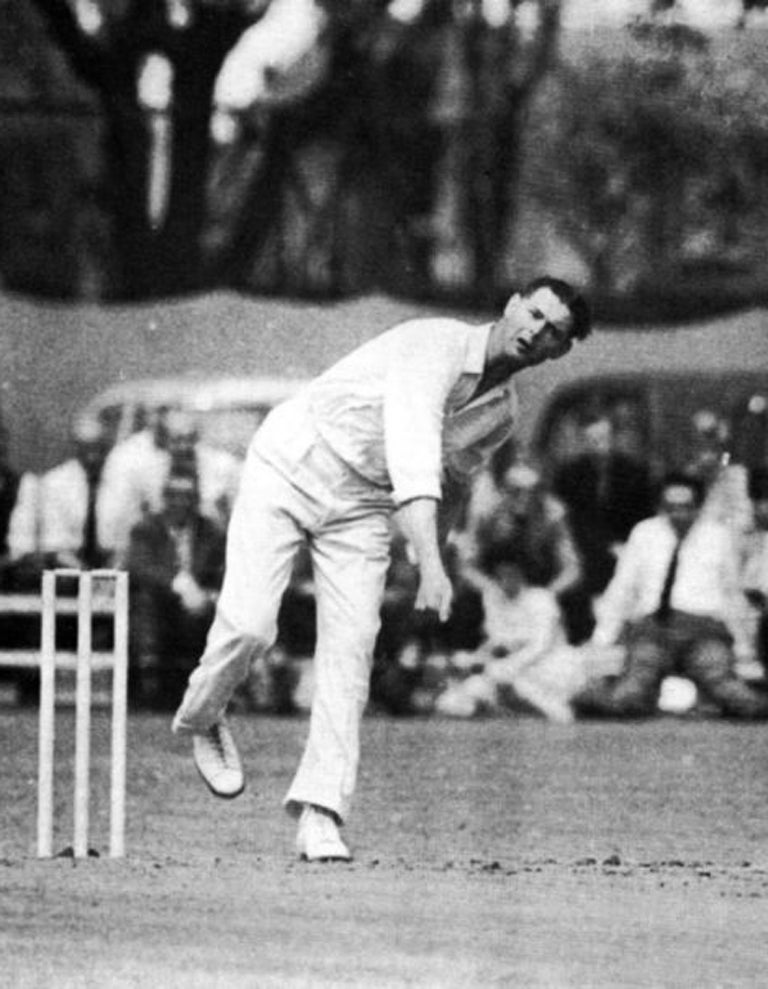Roy Tattersall: Off-spin bowler for Lancashire and England

Although a relative latecomer to the professional game, Roy Tattersall enjoyed conspicuous cricketing success with Lancashire between 1948 and 1960. In 1950, amid a first full season bowling off spin, his haul of 171 wickets helped propel the county to a richly deserved share of the championship title. The following year he won the first of his 16 England caps.
A proud Boltonian, Roy Tattersall was educated at Castle Hill Council School before moving to Folds Road Central School. While there, his prodigious cricketing talent first came to the fore when playing alongside his brothers for local club Bradshaw. Initially serving his time as an apprentice cobbler, a perforated ear drum kept him out of war service. His immediate post-war years, while starring for Tonge in the Bolton League, were spent as an officer at Cheadle Juvenile Delinquent Remand Home.
Tattersall was initially signed by Lancashire to bolster the county's opening attack in 1948; aged 26, and at 6ft 2ins, he was a brisk right-arm medium-pace bowler. However, when witnessed bowling off spin in the nets, it was coach Harry Makepeace who spotted his potential. While not a vicious spinner of the ball, his command of flight, subtle changes of pace and unerring accuracy could, on their day, prove devastating.
Having had a modest start to the 1950 season, it was his 6-69 against Warwickshire at Edgbaston in May that helped set up the first of Lancashire's 16 victories. Impressive 12-wicket returns at Gloucester and against Essex and Worcestershire at Old Trafford inexorably propelled the county to a share of the championship title with Surrey. Invariably supported by the predatory instincts of close catchers Grieves, Ikin and Edrich, Tattersall's total haul of 193 wickets comfortably put him at the head of the national averages. However, while awarded a county cap, his exploits were overlooked by the England selectors.
His test debut eventually came in Adelaide in February 1951, when together with Lancashire teammate Brian Statham, he had flown out to reinforce Freddie Brown's beleaguered troops, then in the midst of an Australian tour. England won only the last test in Sydney and while Tattersall bowled tidily, it was his input as a batsman that helped bring victory. Coming to the crease with Reg Simpson eight runs short of his century, they shared in a last wicket stand of 74. While Simpson took his total to 156, his partner had managed to creep into double figures before Keith Miller comprehensively uprooted his middle stump.
Later that year Tattersall played in all five domestic tests against South Africa, his 7-52 bowling England to a convincing victory at Lord's. While a key member of the England party that toured India in 1951-52, he was soon to be overshadowed by the emergence of fellow spinner Jim Laker. The last of his test appearances came in the drawn game against Pakistan at Lord's in June 1954. In all, he won 16 test caps, taking 58 wickets at an average of 26.08.
Having formed a close bond with his captain at Old Trafford, Nigel Howard, he sadly did not always enjoy the same rapport with his successor, Cyril Washbrook. During the 1956 season, when heading the county's bowling averages, Tattersall was surprisingly omitted from seven crucial championship matches. Soon recalled, he responded in style by taking 26 wickets in the closing five games. Unfortunately, he would never again play a full season for the county.
A left-handed batsman who accrued a seemingly modest total of 1,786 runs from 312 innings, he was nevertheless not without ambition and could defend or attack with the best of them. Against Leicestershire at Old Trafford in July 1958, while Statham claimed the bowling honours, the star turns were undoubtedly Tattersall and wicketkeeper Alan Wilson. Amid Lancashire's first 10th-wicket century stand for 25 years, Tattersall contributed a robust 58, his highest score in first-class cricket.
However, it is his incomparable artistry as a bowler that ensures his place among the game's elite. Exceeding 100 wickets in a season seven times, in all first-class cricket he played 277 games, taking 1,369 wickets at an average of 18.04. Against Notts at Old Trafford in 1953, when he also claimed a hat trick, he recorded his best ever bowling return of 9-40. Never less than a wholehearted and committed team player, he also had 143 catches to his name.
In 1960, Lancashire awarded both Tattersall and teammate Malcolm Hilton a joint testimonial match against Yorkshire, in which neither of them played. While Hilton was exiled to Scarborough to lead the Second XI, Tattersall was forced to watch from the sidelines. Happily, a record crowd of some 34,000, the largest seen at Old Trafford since 1921, earned them well in excess of £11,000.
The following year he settled in the Midlands, working for a carpet manufacturer while playing for Kidderminster. Occasional appearances for Worcestershire Second XI led to a long association with Worcester Ramblers. Here, as always, his record of achievement on the field and his exemplary conduct off it earned him the high regard of everyone involved in the game.
Kenneth Shenton
Roy Tattersall, cricketer: born Bolton, Lancashire 17 August 1922; married (three daughters); died Kidderminster, Worcestershire 9 December 2011.
Subscribe to Independent Premium to bookmark this article
Want to bookmark your favourite articles and stories to read or reference later? Start your Independent Premium subscription today.

Join our commenting forum
Join thought-provoking conversations, follow other Independent readers and see their replies